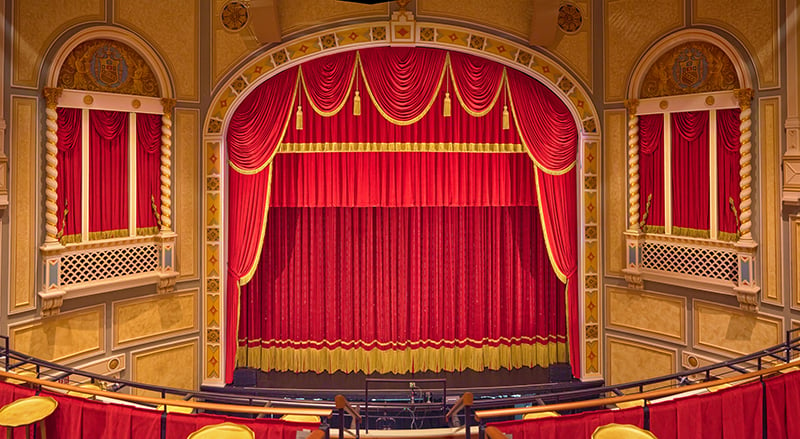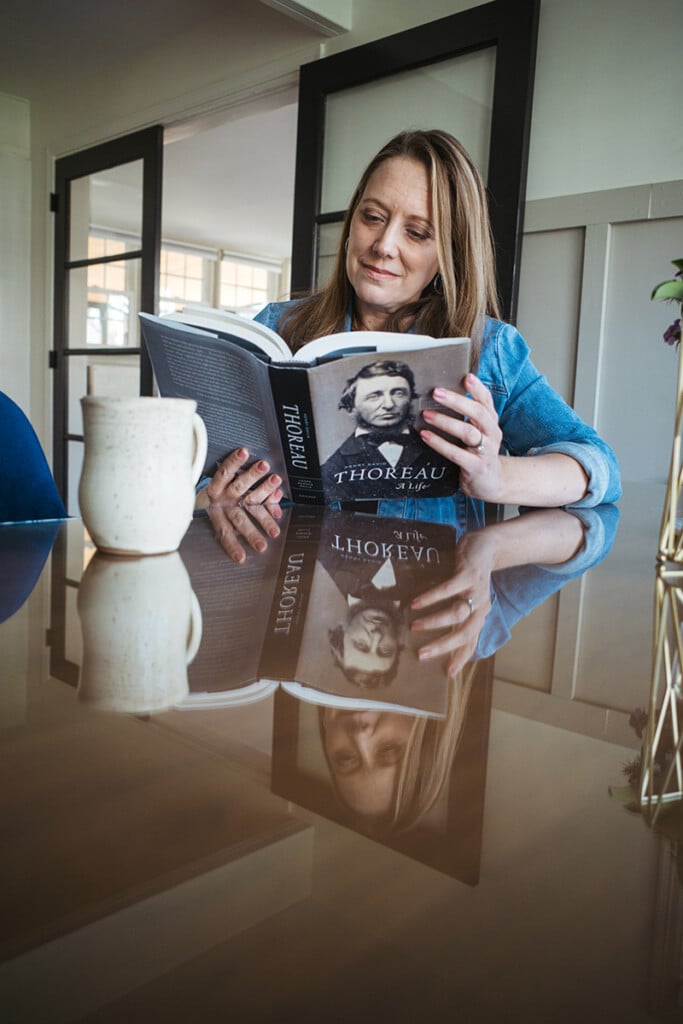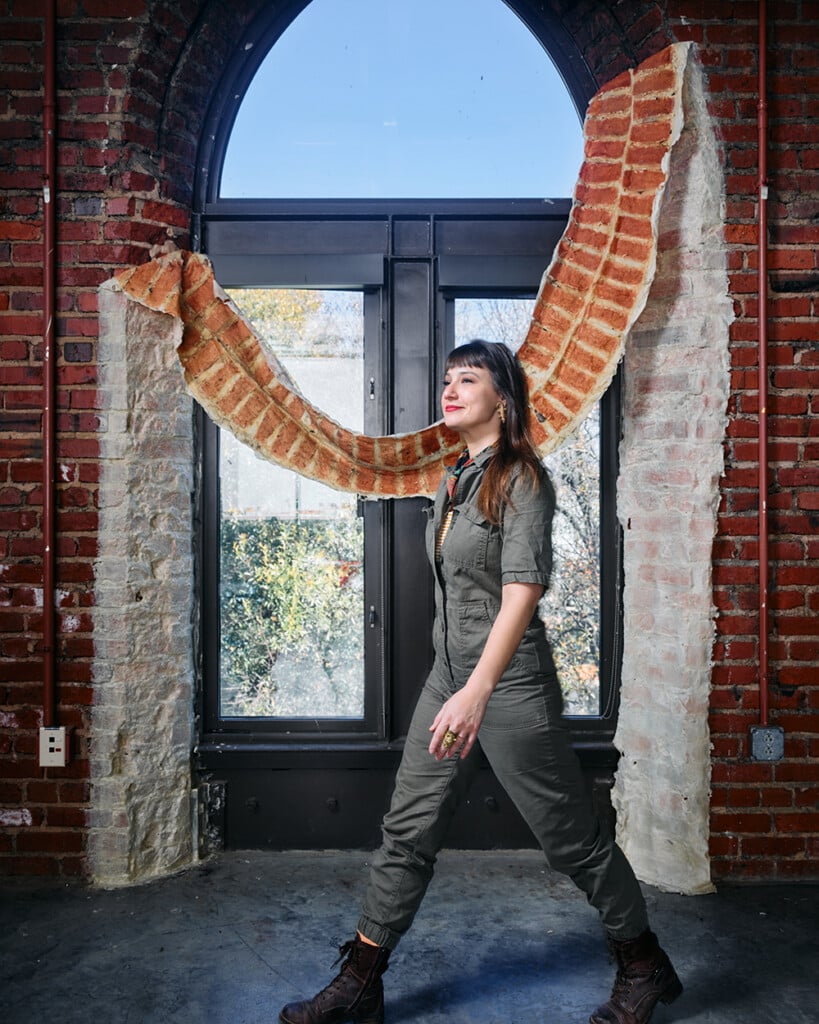What It Took To Reopen The Historic Carolina Theatre
After 47 years, the reopening stands as a testament to good neighbors, good luck, and a dedicated group that refused to watch the curtains close

Billy Clayton, the lead audio engineer at the 98-year-old Carolina Theatre on North Tryon Street, sits in an orchestra seat surrounded by old-school opulence, like he’s Louis XIV in blue jeans: plush seats, crimson curtains with gold tassels, pastoral murals on the walls. He’s 42, and he can appreciate the gilded metal and the ornamental plaster, but he also remembers having his 15th birthday party at the theater when it was a burned-out husk.
He and his friends ran around the abandoned theater, played Tool and the Beastie Boys at maximum volume, and enjoyed the thrill of being in a building that felt like it might crumble at any moment. “The stage was roped off, and on the balcony there was a big wooden rail that you weren’t supposed to go past,” he says. “It was scary—but fun.”
Charlotte’s not the only city with a habit of knocking down its own history rather than celebrating it. That the Carolina Theatre made it through the past century without a date with a wrecking ball, despite being out of commission for more than 40 years, is extremely unusual; that it reopened this year, restored to its former glory, is nothing short of miraculous.
It first opened its doors in 1927, when the city’s population was roughly 70,000, and debuted with the silent movie A Kiss in a Taxi. Touted as a “Cathedral to Entertainment,” it was the first air-conditioned Charlotte building open to the public. In 1938, the theater was refitted for sound so it could play “talkie” movies, but it wasn’t just a cinema. It also hosted vaudeville acts, the Charlotte Symphony Orchestra, and live performances starring Andy Griffith, Katharine Hepburn, and Frank Sinatra. When Bob Hope passed through town, he walked down the sidewalk of Tryon Street, shaking the hands of the people waiting in line to see him in a movie. Elvis Presley played the Carolina Theatre in 1956, two weeks after the release of his “Heartbreak Hotel” single; tickets were 85 cents for adults and 50 cents for children.
An ugly aspect of the Carolina Theatre’s history, part of our state’s racist heritage: For decades, the theater was whites-only. In the late 1950s, Black customers were finally allowed to buy tickets—if they came in a side entrance and sat in the balcony. Finally, in 1963, it was fully integrated.
While the theater had once hosted a variety of entertainment, it became a full-time movie house in 1961. The owners installed an extra-wide Cinerama screen and covered up the walls with dark green curtains. In 1965 and 1966, The Sound of Music played for 79 straight weeks. The theater went dark in 1978; the last movie it showed was the kung fu classic Fist of Fury. When the theater had its grand reopening in March this year, it had been nearly five decades since Bruce Lee shut the joint down.
On a recent Friday morning, the Carolina Theatre hosts a CreativeMornings event, featuring a speech by local photographer Alvin C. Jacobs Jr. The audience includes two 64-year-old friends, Aundora Anderson and Cheryl Hackett Allen, who regularly saw movies there in the 1970s, including Shaft and Blacula. “This is so exciting,” Allen says, “after all these years.”
Anderson remembers the youthful thrill of seeing movies at the Carolina. She knew, as a Black person, that not too many years before, she wouldn’t have been allowed inside. So when she went to the movies there, she reveled in the room’s grandeur every time. “It was a movie theater,” she says this morning, in a tone of voice that makes it clear it was much more than that.
Billy Clayton had his birthday party at the Carolina Theatre because his father, Charlie, was a tireless advocate for the building. He spent decades trying to convince people that it could be a jewel in Charlotte’s crown—if only it were restored properly. The elder Clayton turns 79 this month; ironically, he never set foot in the Carolina Theatre in its glory days. He was born in Charlotte but grew up in Atlanta, where, as a child, he was overwhelmed by the beauty of the Fox Theatre, which opened in 1929. He remembers wistfully, “An organist was rising out of the pit, and I felt like I was in heaven.”
After some years working in Baton Rouge, Louisiana, he returned to Charlotte and joined the Metrolina Theater Organ Society, a group for classic organ music enthusiasts that was founded by John Apple, who told him about the Carolina Theatre. “We started thinking, If we could just somehow figure out how to get that place open, we could restore it; we could put a theater organ in there,” Clayton says. “But all of us were poor, so we had no way of doing it.”
Clayton got obsessed with the idea of salvaging the Carolina, so much so that he learned how to write a grant application. He sent in a request for $30 million to the North Carolina legislature—and was stunned when, months later, he got a call from the state treasurer’s office informing him that it had a check for him. It was only $50,000, but that was enough to establish a nonprofit in 1997. He called it the Carolina Theatre Preservation Society.
“I was just a salesman. I sold process control instrumentation,” Clayton says. “But my main job was saving the Carolina.” The city of Charlotte had acquired the abandoned property; he decided that the crucial thing was to convince them not to sell it to a developer who would knock it down. His biggest obstacle was that since it had been closed for two decades, there was no collective memory of its glory years.
He eventually convinced the city to let him inside. The theater had suffered some serious damage in 1980, when squatters lit a fire on the stage to stay warm—but the building was still standing because the original fire curtain, installed in 1927, suppressed the flames. “It was super-low-tech,” Clayton says. “How they made fire curtains then was, they hoisted them up with ropes and encased the ropes in wax. When the temperature gets too high, the wax melts, and the curtain comes down.”
No electricity meant no lights. But after Clayton went on Mike Collins’ radio show and made a public appeal, Randy Lail, an electrician who remembered the theater, volunteered his services. With his crew, he installed exit lights and wires to a transformer, which was good enough for the city to grant a temporary permit.
Till Schmidt-Rimpler and MyLoan Dinh brought in their dance/theater company Moving Poets for four shows between 1997 and 2000 (adaptations of Dracula, Salome, Frankenstein, and Faust). Conditions were rough. “It was totally disgusting,” Schmidt-Rimpler says, sitting on the porch of the house he and Dinh share. “There were bats and pigeons, and a foot-high pile of dirt, and it had obviously flooded several times, because the drainage didn’t work.”
“No working bathrooms,” Dinh adds.
“Nothing,” Schmidt-Rimpler emphasizes. “And it was damp as hell.” A group of volunteers, including the Moving Poets performers, cleaned up, brought in heaters and folding chairs, and built a stage where the orchestra pit used to be. “We were young, naïve, and strong,” Dinh says.
The city was surprisingly cooperative with the guerilla performance; the theater was able to get a liquor license so it could sell beer out of a coffin for Dracula. The fire marshal paid a visit but let the show go on. “There was nothing flammable in there,” Dinh says with a laugh. “There was nothing to burn anymore.”
The Preservation Society kept bringing people into the theater for tours and events: They got a popcorn machine and projected silent movies. “It was really a community effort,” Clayton says. “It wasn’t just me—lots and lots of people worked on this. We went through 50 board members over the years. A lot of people got discouraged and left. I never did. John Apple never did. I’m very tenacious. Some people might call it stubborn.”
In 2002, the city manager’s office changed its policy toward the Carolina Theatre, deeming it too dangerous, and shut down the Society’s access. Over the next few years, Clayton desperately looked for real-estate mavens and finally found a developer, Jim Donnelly, interested in renovating it. The developer planned to pay for the project by building 22 stories of luxury condos above the theater. “They had presold over 60% of these places, high rollers, NBA stars, NFL stars,” Clayton says. They had a blowout celebration in the theater—and then the 2008 financial crisis hit, and the project got canceled.
“Most of my board members bailed after that,” Clayton says. “It’s not going to happen. Sorry, Charlie, we tried.”
Persistence counts for a lot in this story, but having good neighbors matters just as much. The building next to the Carolina Theatre on Tryon Street hosts Foundation for the Carolinas. The nonprofit community foundation, established in 1958, is the biggest player on the local philanthropic scene by virtue of its $3 billion in assets. In 2012, it decided that renovating the Carolina Theatre was a worthy endeavor because it would benefit the local community and complement the Foundation’s headquarters. In 2013, the city sold the property to the Foundation for one dollar.
“Hope was always there,” Clayton says. “The main thing was to not to let it get torn down.”
The Foundation drew up plans and raised more than $50 million for the renovation—which turned out to be about half of what they needed, as the work extended over seven years. Why so long?
“We thought, ‘OK, we’ve got some good walls here, we can build on that,’” says Sean Seifert, the theater’s executive director. But when workmen stripped away the plaster, they found that the underlying steel was in bad shape. “With all the moisture, and no heating or cooling for 40 years, that was all rusting,” Seifert says, wincing at the memory. “So now we’ve got to take down this whole wall. A lot of the time was because of the unforeseen.”
Seifert’s sitting in the theater’s balcony as technicians adjust the lights onstage, rotating the room through cycles of day and night every few minutes. Fair-haired and unflappable, he’s had a career that’s included construction management, an Ohio ski resort, and the U.S. National Whitewater Center, where he spent seven years as the director of systems and operations. He discusses the time it took to restore the theater’s cosmetic details to how they would have looked in 1927—an effort made more complicated by the absence of color photographs of the interior.
When Cathy Bessant became the Foundation’s president and CEO in January 2024, she asked Seifert to take over the project and finally get it done. He threw himself into it, “got everybody pulling on the rope in the same direction,” and, after about six months, realized he had fallen in love with the dream of the theater just as thoroughly as Clayton had. “I sat in her office and said, ‘This thing’s a part of me now—I want to run it.’”
So where will the Carolina Theatre fit in Charlotte’s cultural landscape? For the most part, it can’t host theatrical productions: The stage doesn’t have the space in the wings required for scene changes. And it seats only 906, which makes it a notch smaller than most venues available to musicians doing theater tours. Seifert operates on the philosophy that if the Carolina provides a first-class experience for both patrons and performers, those issues will take care of themselves. At press time, the biggest names on the Carolina’s 2025 schedule were the long-running country-rock band Pure Prairie League and the storyteller Garrison Keillor.
“We want a lot of our programming to be community engagement,” Seifert says. “We want to bring in speakers that are thought-provoking or have panels where people disagree with each other, and we try to sit everybody down and talk about it.”
For all its old-school extravagance, the flashiest thing about the Carolina may be the “trailer” that the theater projects before a show starts, a three-minute spectacle of digital animation. Part of the renovation’s mission was to equip the theater with state-of-the-art technology but conceal it all from the audience. Seifert leads me on a tour of the backstage area, full of touchscreens and computer servers and cables.
So many bundles of cables, in fact, and so many HVAC ducts, that they fill up the room that once held the Carolina Theatre’s organ. Thirty years after Charlie Clayton first talked about having a place where he could enjoy old-school organ music, he got the theater he dreamed of, and he says it turned out even more beautifully than he had imagined. But there was no room for the organ.









